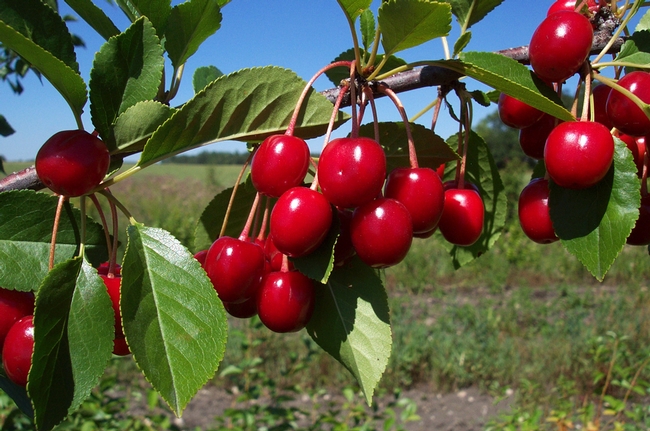- Author: Laura Mogg.
Have you seen the new demonstration plot at Bishop's Community garden? If not, make a trip to the covered picnic area on the Pine to Park path at the back of the City Park, and find a plot with three pole tee-pees. This demo garden was created to inspire children, but instead of a sign saying, “Children's Garden" I think it should be labeled "The Enchanted Garden" to appeal to all who are young at heart.
The garden was planted in early May with flower transplants and seeds, pole beans around the tee-pees, and gourds along the trellis on the north side — very simple. Where there is nothing growing, we will lay a meandering stone path and that is all, apart from the fairy houses. If you don't know what fairy houses are, you'll have to come to find out!
In early June things started to grow, and by the end of summer we hope to have a maze of sunflowers around the beans with children hiding in the tee-pees and playing with fairy houses. By September there should be lots of extra fun with birdhouse and baseball-bat gourds.
Master Gardeners work with the Bishop Community Garden to demonstrate garden practices and to get the public excited about gardening.
Come with your children, grandchildren, or neighbors and watch this new garden grow through the seasons. See you there!
The continuing drought in California and the Western United States has made it necessary for all of us, no matter where we live, to find ways to save precious water. Now that our three sons are out of the house, Lori and I decided that the removal of some grass in our yard would be a start. We could remove grass in a sunny backyard area as a test, and as an added bonus use the newly-cleared space for growing less water intensive, sun-loving vegetables and flowers.
The main problem we had to tackle, aside from the labor required to dig out and dispose of the turf, was how to prevent the grass from growing back and weeds from encroaching on the exposed area. We considered a number of options to eliminate grass including initial removal and continuing weeding, herbicides, tilling, weed cloth, cardboard and newspapers.
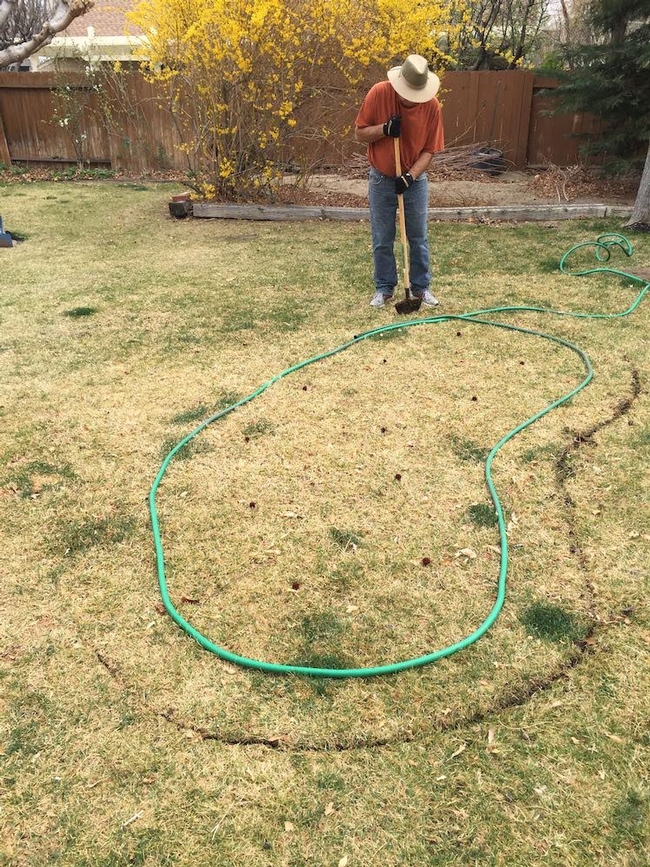 3/17/15: Cutting grass around hose used to mark test area. |
 3/18/15: Tilling area prior to applying newspaper. Note dug out perimeter. |
|
Each of those options brings with it its own advantages and disadvantages which had to be weighed. Continuing weeding to (hopefully) keep grass at bay would be a pain in the neck—and back—and we saw little upside in this option. Herbicides would probably get rid of the grass, but would probably require several applications. Most importantly to me, they are not good for the environment and any future planting we wanted to do, including vegetables. Tilling can harm the natural soil texture, spread seeds and chop up grass into small pieces that can grow. Weed cloth would probably work but it's expensive. Cardboard would probably work too but it's difficult to work with. Old newspapers reportedly work well and they are readily available from the local newspaper office for nothing, and using them carries the added benefit of recycling.
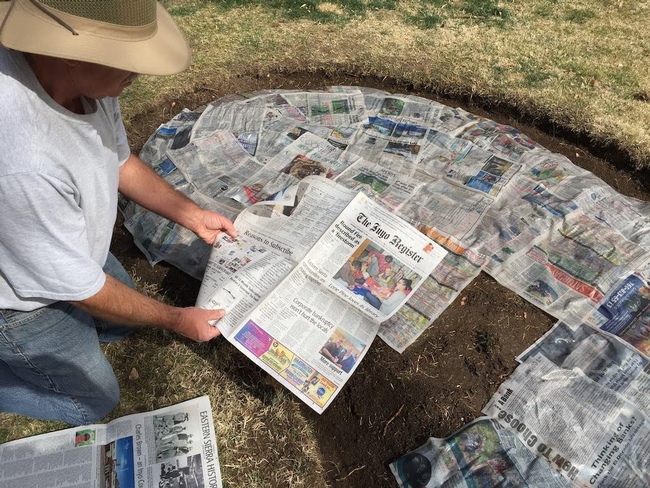
First we needed to select a location where the lawn would be removed. Because we have so many trees in the backyard that shade a lot of area, we selected a location in the middle of the yard that gets as much sun as possible. We wanted to have a sunny location where vegetables and flowers would grow well.
We began the test in mid-March 2015 hoping to get the new area ready to plant before summer. I started by outlining a spot on the lawn using a hose and then proceeding to remove the grass. First I used a cutter to make a nice edge along the hose. I then dug out the edge of the grass inside the cut to a full shovel depth, about six inches. This has the added benefit of minimizing the infiltration of adjacent grass as it cannot easily cross the open space. Next I tilled the grass in the rest of the area, and raked and pulled as much leftover grass as I could.
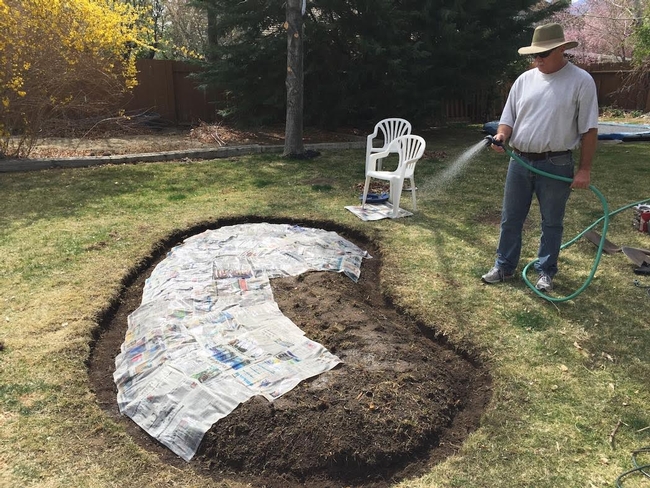
In mid-April we took on the task of getting water to the new planting area. We decided to tap into an existing drip irrigation line that's on a timer and about 25 feet away. I used the cutter to make a line in the grass then dug down and peeled back the grass leaving it attached at one edge to facilitate putting it back once I'd made the water connection. I then dug a trench about 12 inches deep. It was a bit tricky cementing the new connection to the existing pipe which was about two feet deep. Once I had made the connection I ran pipe in the ditch and covered it with the dirt I'd removed and the grass I'd peeled back. Finally Lori connected a drip irrigation system to the new pipe and put heads where we were going to plant.
Then we got to plant! We waited until early May hoping to avoid freezing (it's all a matter of risk tolerance). Lori planted squash seeds, peppers, cucumbers, a gerbera daisy, marigolds and one dahlia tuber we had left over after planting 39 in our existing garden. We've had problems in the past with bugs eating our young plants so we put a fence around the area to keep the dogs out and then Lori sprinkled a bit of snail/earwig bait to give them a chance to grow strong and better survive a pest onslaught.
 3/18/15: Test area with grass tilled, raked and removed, ready for newspapers |
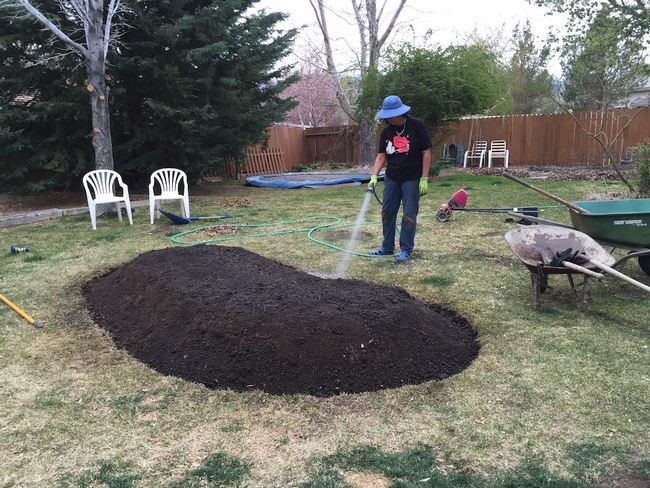 3/18/15: Ready to plant! Just waiting install the drip supply line and warmer weather. |
 4/14/15: Trench dug and drip supply pipe installed and ready to backfill. Note the grass laid over to the left, making it easier to put it back where it came from. |
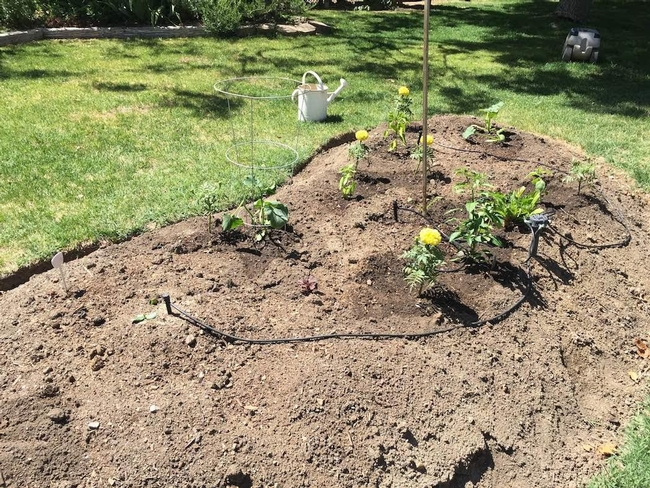 5/10/15: A few days after planting. No grass or weeds have come up. |
It's now June. Everything we planted is doing quite well. On May 26 Lori did some minor cleaning and mulching of the area and found minimal grass and weed infiltration. Since we created the new planting area very little grass has come up, and any that has mostly came from the surrounding grass, not through the newspaper. So, at this point I would call the test a success. I will update this report as the summer and fall growing seasons progress and we have a better handle on how successful the test has been. But, so far so good! If it continues to work this well we may remove more grass in the future using the same method.
I'll keep you posted.
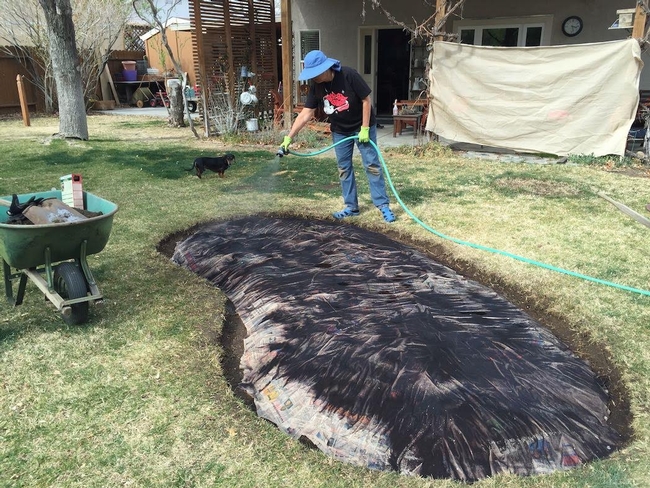 3/18/15: Lori wetting the blood meal spread on the newspapers. |
 5/29/15: Looking good this morning! |
- Author: Dustin Blakey
My family and I just went up Bishop Creek to check out the fall color. You should, too. Its beauty may inspire you enough that you won't mind the drudgery of raking leaves that will be upon us in a few short weeks.
Your trees spend a lot of time gathering nutrients and resources to make leaves, and they're a valuable asset. Maybe not like gold or platinum, but useful anyway.
Leaves are a good way of adding organic matter to a garden or compost pile. You have to do something with them, so why not put them to use after spending all that effort gathering them?
On their own, leaves decompose very slowly. Oaks in particular seem to be in no hurry to break down. In order to speed this process up, the compost pile or garden needs to have adequate nitrogen and moisture available. UC has a couple fact sheets on composting:
- Why Compost?
- Compost in a Hurry (Probably not the most practical system with fall leaves, but good info.)
- SLO Backyard Composting Guide
CalRecycle has information on composting as well. Check out their website.
We tend to be dryer than these other places so our compost needs to be moistened and/or kept covered. Even in winter.
Small particles will decompose more quickly than big ones. I try to grind up my leaves. For everything but my oak tree, I have a leaf blower that reverses direction and turns into a vacuum that sucks and grinds leaves once they're dry. I find that the fastest way. For my oak leaves I have to be more creative...or just patient. It's remarkable how small a leaf pile gets after it has been chopped up.
I incorporate my chopped leaves into my garden and add a little nitrogen and water. By spring they have broken down. I am lucky that I have just the right number of leaves for this to work, but some yards have far too many. Compost piles are a better option in this case.
If you've accumulated pine needles, know that these make an excellent mulch for the landscape. Note that in some communities composting and mulching are frowned upon. Ask your fire department about mulches if you have questions.
We encourage you to make the most of what your landscape gives you. Look into composting yard waste or using it as a mulch.
- Author: Dustin Blakey
To me December represents the nadir of garden activity. It's cold, the days are short, and frankly I'm too worried about surviving Christmas with the kids to think about plants. As far as gardening is concerned, January is a huge improvement over the preceding month.
Maybe you get them sooner, but the companies I buy seeds from send me their propaganda in January. I can't think of anything that instills more of a sense of optimism and confidence in one's ability to raise a garden than a seed catalogue. Thankfully my lousy soil and uncooperative weather conspire to ensure I am fully humble by August when I'm left with not much more than some basil, cherry tomatoes, and maybe some sunburned peppers.
But today I'm excited! August is a long way off.
This weekend I'll probably put in my order for seeds for 2014 if I don't have to put in too much time toward child supervision.
This is the time of year you need to start thinking about what you want to grow and where you'll get the seeds or transplants. I usually just use what ever tomatoes and peppers I can find transplants for locally, but when I want a specific cultivar, then I will need enough lead time to grow the transplants in order to have them ready in time for spring. The time to sow vegetable transplants is getting close. If your seed order is still a to-do item, you may miss your chance to grow your own transplants. Don't delay! Operators are standing by.
You probably need to sow about 6 to 8 weeks before transplants are set out in the garden. If you grow cole crops from seed instead of buying transplants that means you need to be sowing soon!
Be sure when you make your seed order that you get enough for your fall crops. It is hard to find seeds or transplants in late summer and the seed companies may be sold out of the kind you want.
Remember that seed companies' writers always describe their offerings as amazingly super-awesome, but clearly not all can be. I recommend experimenting a little because that's fun, but don't be afraid to grow tried-and-true cultivars that worked for you in the past. Likewise when you can't find your favorite, don't worry about it. They usually drop poor sellers that either perform poorly compared to their other cultivars, or are just too hard to produce. In other words, there's usually a good reason you can't find it.
You can always ask a Master Gardener or a friend what they grow, as well. In some cases it just doesn't matter at the small scale of a home garden what you pick. I've always been impressed with eloquent descriptions of items like radishes. Is there really a radish worthy of a J. Peterman treatment?
Most seed companies buy many of their seeds in bulk from suppliers and repackage them. If you see the same cultivar available elsewhere–and it's packed for the current year–don't be afraid to go with the cheaper option. Sometimes you're just paying for a fancy seed envelope, shiny catalogue, or great story. (Ask me about kiwanos some time.)
Finally, plant what you like to use. If you don't like turnips, they don't need to be in your garden. Plant more of what you like instead! I find myself planting radishes, eggplant and squash each year because that's what you grow in a garden, but I really don't like them. Every spring I think that this will finally be the year I like squash, but it has yet come to pass. As I'm fighting squash bugs in July I annually conclude that I would have been happier with that space planted in bell peppers.
Maybe this will be the year I only buy seeds for what I like and will grow, and do it early enough to plant on time. But don't bet on it.
I'm sure you'll do better than me.
- Author: Dustin Blakey
Selecting Fruit Trees
Dustin Blakey, Inyo-Mono Farm Advisor
Fruits are always favorites in the garden. Eat a fresh peach or plum and you’ll be obsessed with getting your own source of ripe fruit that you can share with the crows. If you are interested in growing your own fruits, fall is the season to get started.
Impulsive acquisition of fruit trees and berries while out on a shopping trip often leads to disappointing results. Not every variety of fruit can be grown on the Eastside. Plants bought on a whim or chosen because you recognize the name may not thrive in our climate or produce the best possible fruit. I am always amazed by how many ‘Red Delicious’ apples get planted in gardens each year, yet I have never met a person who actually likes to eat them!
There are two tried and true ways to get fruits (trees or berries) for your garden: you can go to a local, knowledgeable nursery in spring and buy containerized plants, or you can order bare-root plants in fall for shipment in spring. If you elect to order fruits from a mail-order nursery, you should make your selections in fall. If you snooze, you lose! Variety choices become meager as spring approaches.
As a rule, bare root trees are cheaper and because you can choose from many vendors, selection is best. The nurseries know when to ship, and you will get your plants still dormant. The disadvantage is that you need to be ready to plant when they arrive or they may die.
Some fruits will need to be cross-pollinated. Most catalogues and websites will mention this and will provide a pollination chart to help you choose.
The following are helpful hints in selecting what fruits to plant:
- If they are adequately watered, brambles (canefruits) are probably our best fruit crop. Look into planting modern cultivars. You may reminisce about a certain berry you once ate in your youth—and it may be great—but great breeding work has been done on blackberries and their kin in the past 30 years.
- Stone fruits are the least reliable of our fruit choices. They tend to flower early and get zapped by cold. Apricots and almonds are especially bad. Try to choose late-flowering types; these tend to be late-bearing as well.
- Apricots, peaches, nectarines, and sour cherries do not require cross-pollination. Sweet cherries do. Apples, pears, and most plums need cross-pollination.
- Even if a crop doesn’t require cross-pollination, having more than one variety can extend your season and a few self-fruitful crops like blueberries do better with cross-pollination.
- Most table grapes do fine here. We don’t raise them, but muscadine grapes will grow here and are a unique treat. ‘Carlos’ and ‘Noble’ are good muscadines to start with.
- If you order figs and they arrive before nights are consistently over 40°F, pot them up and keep them inside until it is safe. ‘Mission’ is not reliably hardy here.
- In most cases, when you have the option to do so, choose a dwarf rootstock.
- Pomegranates are hardy in the Owens Valley but may have issues with frosts and too short a growing season, especially in Bishop, for some varieties. Plant with caution.
- Remember that grocery store fruit is not being grown locally. In most cases, the variety you should grow in your garden will not be the typical ones seen in the produce department.
- Common California varieties and growing information can be found at The California Backyard Orchard.


